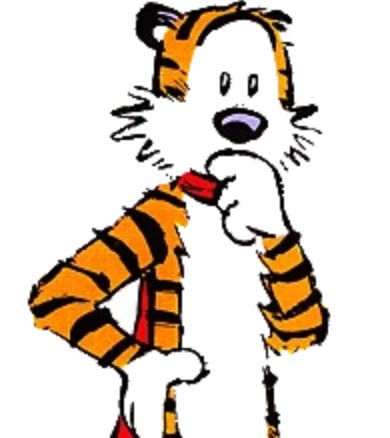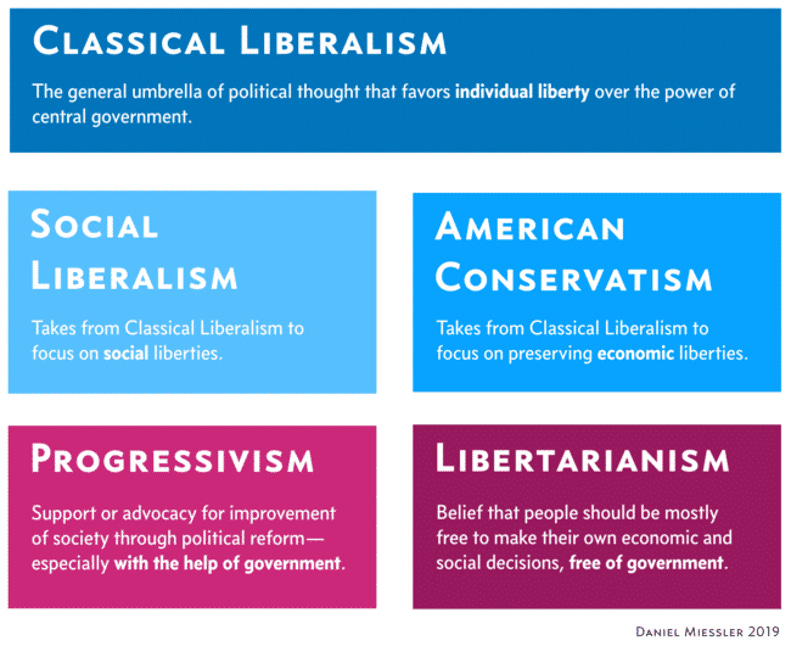Recently a pal asked me about the difference between Classical Liberalism and Libertarianism, so here’s a down and dirty comparing the two points on the political spectrum sharing “Liber” (freedom!) in their name.
For my own story and my interest in this discussion: As the wave of Woke socio-political propaganda swept the nation over the past 5 years or so, converting thousands of individuals, educational institutions, corporate and non-profit organizations, the media, our arts and entertainment, science and medicine, law, the military, our government and more to its neo-Marxist identitarian politics (known most accurately as applied Critical Theory), I looked up one day to find that many people I knew, especially in Woke uber alles Portland, had shifted rather dramatically to my left.
After a short period of contemplation, and a far longer period of study, I found myself able, with a little knowledge and a little more context, to reject Wokism for a clear concept of who I was in terms of my socio-political outlook. Have always been, really: but now I had a definition, and in these par’lous times, I felt one was needed. I was, am, a classical liberal of the Age of Enlightenment stripe.
In somehow finding myself deaf to Wokism’s siren song – a stroke of luck, as it catches many well-intentioned Liberals in its maelstrom – I had a chance to examine other stops on the socio-political path. And this is where Classical Liberalism comes in handy. This phrase is not a descriptor for what we Americans know as “liberal.” You know: Our down-ticket-blue-voting-eco-mad-recycling-also-cycling-pro-immigration-pro-choice-meat-free-Mondays-or-vegan-all-the-way-yeah-climate-change-is-a-thing-spiritual-but-not-religious-yadda-yadda card carrying Democrat.
Rather, the term “liberal” has to do with a broad-based view of the world that takes into consideration studies of language, philosophy, literature, abstract science and other areas, whether learned under a Yew tree or in university – general knowledge meant to develop the intellectual capacities required of good civic participants, such as critical thinking, reason and judgement. This, as opposed to or as a foundation for any professional or vocational skills based upon it. It is characterized by open-mindedness, and an ability to see past the orthodox to the heterodox in our ongoing wrestling match with truth, and our conception of reality.
That means, both capital-L Liberals, and capital-C Conservatives can both be lower-case classical “liberals” in this sense. Now mind you, the divide between the Donkeys and the Elephants has been widening for some time, and it’s hard to imagine either end of our political rainbow embracing the descriptor today – they’re gripping their own precious brand way too hard for that. Nevertheless, the term allows room for anyone to be a classical liberal, along with a narrower expression of their views, if they want to be.
So as I fretted about whether my former Leftie allies had orphaned me, or whether it was the other way around, I took a look at Libertarianism as another tension point in the American socio-political tug-of-war.
Brrr: Libertarian. the very word gave me the chills. As an old-school blue dog Democrat, as a unionist, as an animal rights activist, as a natural-born nurturer and as someone who thinks Ayn Rand was just mean and weird, to me, “Libertarian” has always meant “Me, first,” it meant “I got mine, grab yours or go to hell,” it meant “Yeah, there’s room for you on the lifeboat, but I don’t want your kind in it,” it meant Bizarro Darwin was their bae.
So using Classic Liberalism both as lens, and in contrast to Libertarianism, here’s what we find.
The below is taken, somewhat intact but with paraphrasing, re-organizing and editing, from a good article on the topic: https://danielmiessler.com/blog/the-difference-between-classical-liberalism-and-libertarianism/
Briefly, lines of socio-political thought developed thusly:
Classical Liberalism was a strong counter to previous political movements that placed authority in the hands of churches, monarchs, or governments. Its central theme was the freedom of individuals rather than central authorities, and the idea was spawned by a number of original thinkers like Adam Smith, John Locke, and others as a response to the industrial revolution and population growth in the late 1800s. (Don’t forget Thomas Hobbes!)
Social Liberalism and Conservatism emerged from Classical Liberalism in the early 20th century.
Social Liberalism focused on having the government still manage much of the economy, but with more social freedoms.
Conservatism focused on the government still upholding traditional social norms, but allowing economic freedoms, especially regarding the use of free markets.
Progressivism emerged from Social Liberalism, and focused on societal improvement through government aid.
Libertarianism emerged from Conservatism, and is the philosophy of liberty from the perspective of its modern revival from the late sixties-early seventies on. It argues that individuals should be left alone, without much influence from central government, and that personal responsibility is the most powerful ingredient of success.
Classical Liberalism, therefore, is the philosophy of political liberty from the perspective of a vast history of thought, which has existed since the 1800s and continues up to today, with Social Liberalism and Progressivism descending from it on the left, and American Conservatism and Libertarianism descending on the right.
A few more comparisons of interest:
Classical Liberalism was originally a break away from churches, monarchies, and powerful and prescriptive governments, with a counter-focus on freedom of the individual. In contrast, Libertarianism emerged much later, and with a focus on further reducing both government and social aid.
Classical Liberalism was a backlash against theocratic monarchies and oppressive governments, while Libertarianism is more of a response to a bloated and overreaching government and welfare state.
Libertarians believe the government should stay out of both social and economic issues, meaning they tend to offend both Social Liberals and Conservatives, for opposite reasons.
While we could take a much deeper dive into Libertarianism, this infographic from www.lp.org is worth a thousand words, I think.
One more nuance to bring us up to the present day: the difference between Classical Liberalism and modern Liberalism is that Classical Liberalism wanted to reduce government involvement and focus on individual freedoms, while further left-centered modern Liberalism is Progressivism, which believes the government should be used to accelerate progress towards its definition of fairness and equality.
Here’s what this all looks like (taken from Daniel Miessler’s website):
My examination of Libertarianism, as compared to Classic Liberalism, confirmed for me that it is too individualistic for my taste. My social concerns and belief in a government that wisely extends a helping hand to those needing it dictate that I will remain where I have been since my first presidential election (McGovern ‘72, the first of several spectacular losses for my new team): a left of center classic liberal of the Age of Enlightenment stripe.
So the Libertarians will remain on my right, with my former lefty political comrades gone to leftier lands. And while I vigorously disagree with their reasons for departure and their present direction, and believe a devotion to the Sirens of Wokeism may lead to democracy’s swan song, as a classical liberal … I have to defend their right to that decision. By the same token, it also means my work is to continue to promote the gorgeous principles of that same philosophy, namely:
Human Dignity - The foundational principle that every person possesses dignity simply by virtue of the fact that they are human beings. This starting point is a defining principle that grounds other core concepts within the classical liberal tradition.
Individual Freedom - The default starting point classical liberals favor, as it leads to patterns of widespread human flourishing. Individual freedom is the primary political value within the classical liberal tradition.
Voluntary Action - The presumed standard for how we achieve what classical liberals take to be the social ideal: a society of mutual benefit based on peaceful cooperation.
Justice - The principle that the individual rights of all must be respected.
Toleration & Pluralism - The principle that so long as someone is not substantively harming others, their behavior, speech, and views should be legally permitted. This variant of toleration is put in service to defend freedoms of speech and expression.
Freedom of Expression - The right to voice his or her own opinion, fearlessly and publicly.
The Rule of Law - The principle that society must be governed by rules that apply, impartially and equally, to all people.
Civil Society - The sphere of voluntary human action that exists between the individual and the state.
Spontaneous Order - The idea that much of the order within society arises by bottom-up processes of trial, error, learning, and course correction.
Intellectual Humility - The power and limits of reason.
Economic Freedom - The principle of economic freedom over policies grounded in the principle of economic control.
Peaceful Solutions - The notion that peaceful solutions are key to fostering a society in which individuals go about their daily affairs in a context of voluntary cooperation and in the absence of violence or war.
For me, the liber in Classical Liberalism is truly the key to remaining free, and to ensuring those freedoms strengthen, thrive, and endure.
Notes from the Daniel Meissler article:
1. I created the diagram myself using my own hybrid paraphrasings of multiple definitions across multiple sources. Because meanings change so quickly, and because we’re in the midst of such a quick change right now, I felt I needed to take that (ahem) liberty. When I tried to use more formal definitions they lacked clarity, concision, and/or context. If you’re a Political Science expert (I’m not) and I’ve offended your profession, please tell me how I can tweak them to be more accurate.
2. For the record, I know many good-hearted Libertarians and Conservatives. Just because I think this particular strain of wordsmithing is bankrupt doesn’t mean I think there’s no merit to any of these anti-government arguments.
3. Here’s another article that claims there are other differences. I think it’s good, and probably valid at some point. But I think the current climate negates much of the nuance presented there. link
4. Don’t start with the anti-progressive/modern liberal stuff here. That’s a separate argument to be had in a separate thread. This one is just about the definition of Classical Liberalism.
5. SOURCE: https://www.sciencedaily.com/terms/classical_liberalism.htm
6. SOURCE: https://thinkmarkets.wordpress.com/2014/02/05/libertarianism-and-classical-liberalism-is-there-a-difference/








